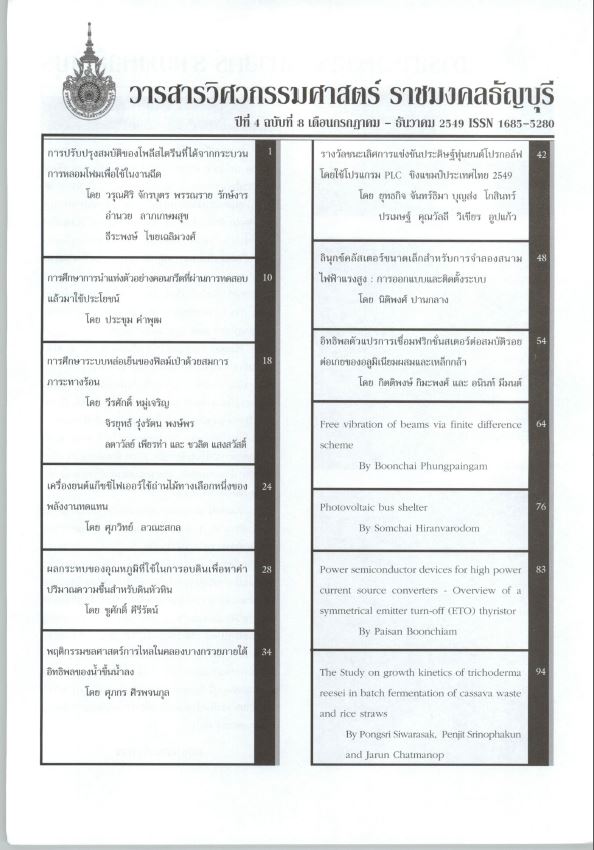The Study on Growth Kinetics of Trichoderma reesei in Batch Fermentation of Cassava Waste and Rice Straws
Main Article Content
Abstract
The objective of this study is to determine the growth rate of TriclJoderma reesei from batch fermentation in liquid medium by using single substrate as carbon source which were cassava waste and rice straws. It was found that 12. 5 % and 8.2 % by weight of maximum reducing sugar obtained from 60 g/l, of each substrate in liquid medium fermented with 0041 g/L of Ttichodetmu reesei RMUTTO I at pH 5 and shaking speed of 120 rpm at room temperature (32 degree Celsius). for 7 day s and 5 days fermentation time of cassava waste and rice straws respectively; the maximum specific growth rate of TriclJodenna reesei ([mu]max) in cassava waste and rice straws fermentation is 0.97 per day and 0.16 per day and saturation constant (K[subscript s]) is 143.13 and 36.35 gram/liter respectively.
Article Details
The manuscript, information, content, picture and so forth which were published on Frontiers in engineering innovation research has been a copyright of this journal only. There is not allow anyone or any organize to duplicate all content or some document for unethical publication.
References
Siwanusak Pongsri, 2002. "Experimental Research of Ethanol Fermentation from Rice Straws and
Bagasse" in ISAF XVI-International Symposium on Alcohol Fuels The Role of Alcohol Fuels in Meeting the Energy, Environmental and Economic Needs of the 21 " Century. pp. 2002-FT-17. Bangkok.
Thailand: National Metal and Materials Technology Center (MTEC).
Siwarasak Pongsri. 2003. "The Study of ethanol fermentation from reducing sugar of rice straws by enzymatic hydrolysis with T reesei." 13 th Annual Conference of Thai Chemical Engineering and Applied Chemistry. pp B-01 (1-9). Srinakharinwirot University. Nakorn-Nayoke. Thailand.
Siwarasak Pongsri. 2004. "The Study on Cellulose of Rice Straw Enzymatic Hydrolysis Condition with T.reesei." in Regional Symposium on Chemical Engineering 2004.Bangkok, Thailand. Dec. 1- 3, 2004: p.124 (KM-203)
Eva Palmqvist. 1996. "Design and Operation of A Bench-Scale Process Development Unit for Production of Ethanol from Lignocellulosics''Bioresource Technology. Vol. 58. pp. 171-179.
Cholada Suesat. 2003. Utilization of Cassava Waste for Ethanol Production. Master of Science.Kasetsart University. Banhkok.Thailand. 92 pages.
Sunee Chotineranart. 1996. Reducing sugar Production from Cassava Waste by Using
Emzyme and Ultrafiltration. Master degree the sis. Chulalongkorn University. Bangkok.Thailand. 97 pages.
Sriroth, K., R. Chollakup, S. Chotineeranat, K. Piyachomkwan and C.G. Oates. 2000.Processing of Cassava Waste for Improved Biomass Utilization. Bioresource Technology.71:63-69.
Shuler, L. Michael and Kargi Fikret. 1992.Bioprocess Engineering Basic concepts. New Jersey, Prentice Hall, Inc. 479 p.
Fogler, H. Scott. 1999, Elementary of Chemical Reaction Engineering. 3" edition. New Jersey, Prentice Hall, Inc. 967 p.
Amnuay Kwanmuang. 1995. Alcoholic Fermentation of Crop Residues Using Cellulase and Saccharomyces cerevisiae. Master degree, Faculty of Science, Chulalongorn University.Bangkok. Thailand.
Biotechnolgy Laboratory 1. 1997. Faculty of Technology. Khon Kean University. Thailand.
Desgranges, C., C. vergoignan, M. Georges and A. Durand. 1991. Biomass estimation
in solid state fermentation. Appl. Biochem.Biotechnol. 35: 200-205.
Chaptin, M.F. and Kennedy, J. F. 1987.Carbohydrate Analysis and Analytical Approach.
Busto, M. D., M. Ortega, and M. Perez-Mateos.1996. Location, kinetics and stability of cellulase
induced in Trichoderma reesei cultures. Biores.Technol. 57:187-192.
Tengerdy, R. P., W.H. Rho, and A. ohagheghi.1991. Liquid fluidized bed starter culture of
Trichoderma reesei for cellulase production. Appl.Biochem. Biotechnol. 27:195-204.
Lee, R. Lynd et all. 2002. Microbial Cellulose Utilization: Fundamental and Biotechnology.
Mocrobiology and Molecular Biology Review.66:506-577.


